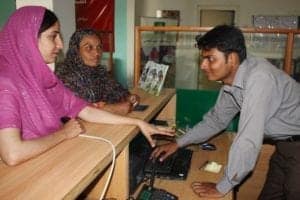When you ask financial service providers in Pakistan about reaching women customers, you mostly hear about the many challenges. They cite women’s restricted mobility, low levels of literacy, unfamiliarity with technology, and lack of need for financial services. Apart from perceiving the women’s market as too difficult to be viable, recent growth in their traditional business lines gives commercial financial institutions little incentive to invest in a new segment. It thus comes as no surprise that nearly 90% of women in Pakistan (approximately 50 million) remain unbanked (2015 Access to Finance Survey). The Global Findex and InterMedia’s FII data put the rate of exclusion even higher, at 95%.
These 50 million unbanked women represent a tremendous missed market opportunity for Pakistan’s financial service providers, especially since many of the oft-mentioned challenges around reaching women are, in fact, myths.
Busting the Myths about Banking Women Customers
Myth #1: “Women don’t need financial services”
Traditional gender roles in Pakistan consider men as the family breadwinners, while women typically care for the household and children. Hence, the ‘common sense’ that women have no money to save and thus no need for a bank account. However, in reality, it is accepted and expected for women to put money aside for family needs. Even women who do not earn an income are expected to do so, as they still often manage money received from a husband and adult children. Women are also increasingly generating income of their own: a 2013-14 survey by the Pakistan Bureau of Statistics found that 26% of women (about 15 million) participate in the labor force. So Pakistani women are managing money and thus need financial services that will give them greater choice and greater security in managing their personal and family funds.
Myth #2: “Women are illiterate, so they can’t use financial services”
 It’s easy to see where this myth comes from: Pakistan’s female literacy rate of 43% is notoriously low, compared to 70% literacy among Pakistani men and 61% literacy among women in the South Asia region. However, a low literacy rate is no excuse for financial service providers to leave 90% of women unbanked. Literacy rates among certain segments of women in Pakistan are actually much higher: 67% among young women ages 18-24, and 79% among women who own phones. Plus, recent work by MicroSave demonstrates that even oral users can engage with appropriately designed financial products.
It’s easy to see where this myth comes from: Pakistan’s female literacy rate of 43% is notoriously low, compared to 70% literacy among Pakistani men and 61% literacy among women in the South Asia region. However, a low literacy rate is no excuse for financial service providers to leave 90% of women unbanked. Literacy rates among certain segments of women in Pakistan are actually much higher: 67% among young women ages 18-24, and 79% among women who own phones. Plus, recent work by MicroSave demonstrates that even oral users can engage with appropriately designed financial products.
Myth #3: “Women don’t go outside their homes, so they can’t use financial services”
While cultural norms do constrain women’s mobility in Pakistan, many women regularly move about in their communities, often in the company of family members. In addition, the Asian Development Bank found that 70% of employed women in Pakistan work outside the home. That means there are over 10 million women regularly operating in the public workplace, plus another million or so who are university or vocational students. Financial service providers must recognize that women are not un-reachable customers, but differently reachableIn the context of cultural norms that often separate by gender, women are likely to have different preferences how they use or access financial services. Providers must adapt traditionally male-focused offerings to meet women’s needs.
Myth #4: “Women don’t own phones, so mobile banking isn’t an option either”
Over 20 million women in Pakistan (36%, according to the 2015 FII survey) own a mobile phone. While this leaves many more women with only partial or no access to mobile, an initial women’s market of 20 million is no small segment. GSMA projects that mobile subscriptions in Pakistan will continue to grow rapidly, so the women’s market opportunity for branchless banking will likely only improve.
Shifting the Paradigm

Once more private sector players understand the opportunity and decide to act, it will be upon them to design products and services with women’s needs in mind. This does not mean developing women-only products. Rather, they must cast a critical eye to how existing products could be tweaked to better serve women customers. For example, Women’s World Banking is currently working with one of Pakistan’s leaders in branchless banking, JazzCash, to increase women’s uptake and usage of the JazzCash mobile account. To do so, we are designing and testing solutions to improve the onboarding process for women customers through both agents and customer referrals.
As women’s financial inclusion advances in Pakistan, financial service providers will also need to explore innovative models to serve some of the harder-to-reach segments of women, such as those in lower-income and more rural communities. Cross-sector partnerships between commercial financial institutions and organizations that already have trusted relationships with women in these communities hold strong potential to help overcome initial barriers of distrust and unfamiliarity. Women’s World Banking will also be exploring this type of opportunity as part of our project with JazzCash.
While there is a long way to go towards achieving full financial inclusion in Pakistan, thoughtful, market-driven solutions have huge potential to bring large numbers of unbanked women into the formal financial system. Because really, who wouldn’t want to capture a market of 50 million customers?
Cross-posted on the Karandaaz blog




